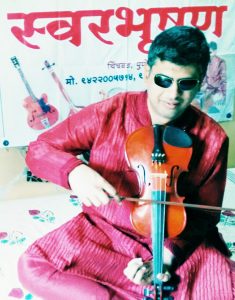

Part 2 contd.
Raga Alapana
While doing Raga Alapana an artist should take care of the following.
Often there can be a doubt as to the correct Melakarta of a Ragam. If we do not do the correct classification of such Ragas, our Raga projection will not be correct. For example, Mohanam can be classified under either Kalyani, Vachaspati, Shankarabharanam, and Harikambodi. In order to determine one of these 4 we have to be aware of the Oscillated and the plain notes in the Raga. to cut the long story short, based on the oscillated and plain notes in Mohanam, it should be classified in Kalyani, as In Kalyani also, every note can be oscillated, or can be also rendered plainly, depending upon the context. Similarly, Begada should be classified as a Janya of Harikambodi, instead of Shankarabharanam, as Kaishiki Nishadam/Ni2 is more often used in it, as compared to Kakali Nishadam/Ni3. [Ni3 is only used in fast phrases in Begada.]
2. Avoid overdoing Vishesha prayoga-
in Reetigowla, the default phrase is Ga Ma Ni Ni Sa, while phrases such as Ni Dha Ni Sa Resa, etc. should be used once in a while, as overdoing those may take you to some other Raga. there are certain non-default phrases, that are used in some compositions, as a poetic license, but in Manodharma, they should be avoided, as they do not adhere to the Raga structure.
3. Beware of the exact oscillation and spacing of notes- continuing the above Reetigowla example, one must know that Ri, and Dha should be rendered almost on Ga and Ni respectively. So even when someone is singing Ri, he should think of singing Ga, to get the correct Shruti of Ri in that Raga It's also important to space the notes correctly in any phrase. A phrase may consist of the slow, medium, and fast parts. Even in the fast part of the phrase, the artist should be able to see/feel each and every note.
4. Correct syllables at exact places- always avoid extra syllables, as lesser syllables will make the phrase classy. Also, avoid harsh syllables like Ri [since it’s a Swara syllable], Ra [since it sounds harsh], or La [since it's too soft]. Aa is the best syllable, along with Ta and Na. Do not give extra Karvai towards the end of any phrase, since it just shows that, you are not confident about the correct finishing of the phrase.
5. Raga personality- Some Ragas like Sarasvati Manohari, KokilaDhwani, etc. depend on their exact sequence, while some Ragas can be developed by elaborating various notes. Some Ragas like Arabhi are assertive, while Ragas like Varali are Tranquill. A student must develop a feel for the Raga, by listening to a lot of great artists, and practicing a lot.
Neraval
Neraval is the merger of Raga Bhava, rhythm, and lyrics. It’s the convergence of the creativity of the composer, and the performing artist. While choosing the Nereval line, one should choose a line that forms a complete sentence, which conveys a positive thought and is melodically good as well. the line should consist of 1, or maximum of 2 Avartanas. Care should be taken to pronounce the lyrics correctly. Composition structure should not be manipulated. In other words, each syllable of the line should fall on the exact bit of the rhythm, as originally structured by the composer. To begin with, a student should practice doing Nereval in one/two notes, which helps in better elaboration.
Tanam
One should not use 2 nasal syllables like Num, one after another. One can say Tum multiple times, but should not say Num repeatedly. With practice, one can create multiple kinds of patterns like +5, or 3+3+3+7 etc.
See the lec-dem here.
Conclusion
The essence of Manodharma is to be creative while being loyal to Raga, and Tala, and by abiding by the various requirements of Alapana/Nereval/Thaanam. To accomplish one must inculcate Dharma [the correct things] through listening to great artists, learning from the right Guru, and rigorous practice. Once someone masters Dharma, correct creative ideas will come to him. So in other words, one’s creativity should reflect his depth of knowledge/practice.
